Critical Analysis of Numeracy Theory, Learning, and Teaching Methods
VerifiedAdded on 2022/12/22
|10
|2492
|62
Report
AI Summary
This report provides a comprehensive overview of numeracy theory, exploring various learning theories such as behaviorism, humanistic theory, constructivism, and social cognitive theory. It critically analyzes each theory, highlighting their strengths and weaknesses, and examines how these theories have influenced current principles of effective teaching in mathematics and numeracy. The report engages with recent scholarly literature to support its analysis. Furthermore, it offers two practical examples of numeracy learning activities, drawing on personal experiences and reflexivity regarding the author's beliefs and practices. The report concludes with a summary of key findings and a reflection on the importance of learning theories and teaching principles in fostering effective numeracy education. The report is a valuable resource for students and educators seeking to understand and improve numeracy learning and teaching methods.
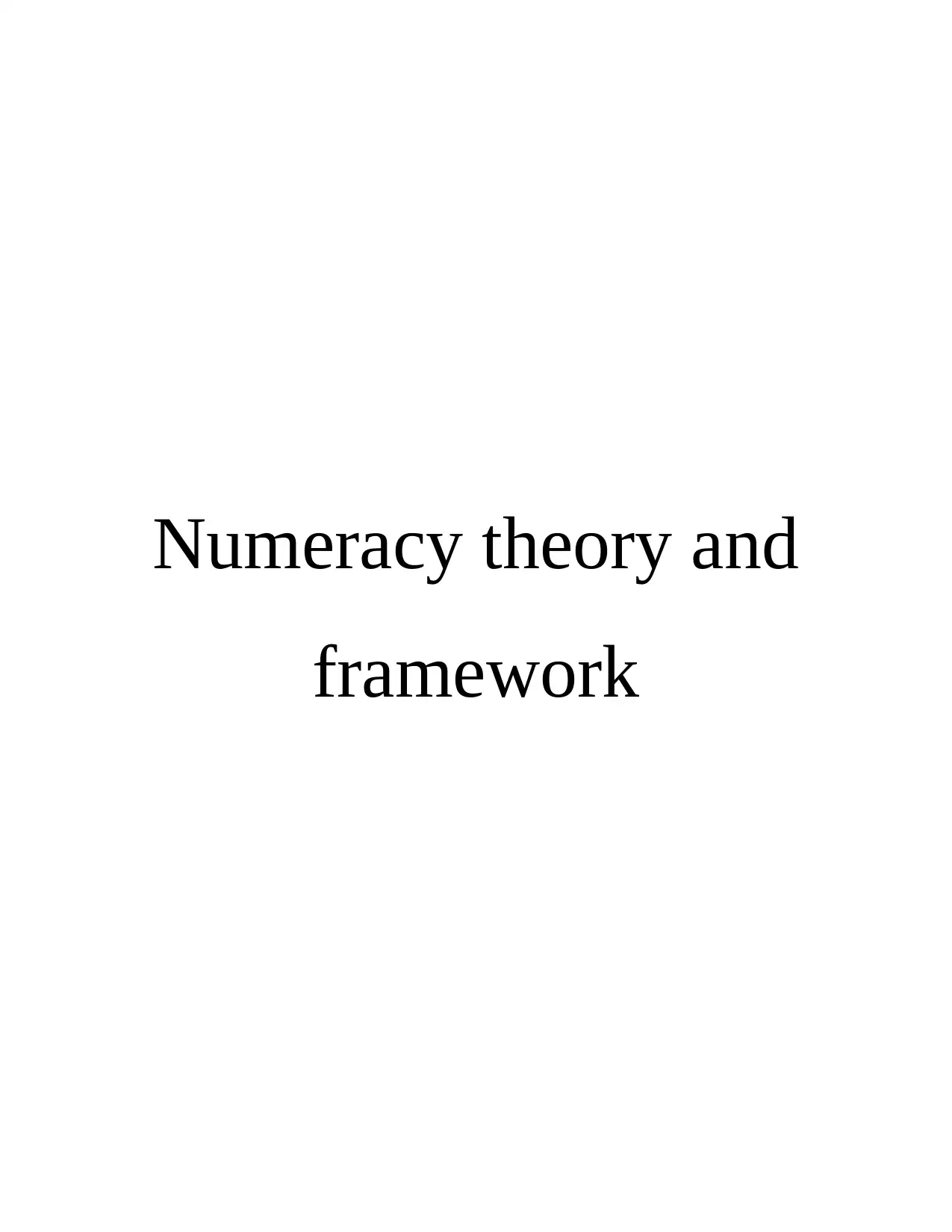
Numeracy theory and
framework
framework
Paraphrase This Document
Need a fresh take? Get an instant paraphrase of this document with our AI Paraphraser

Table of Contents
INTRODUCTION...........................................................................................................................3
MAIN BODY...................................................................................................................................3
Critical analysis of major learning theories and their development.......................................3
Analysis of how learning theories have led to current principles of effective practice in
teaching mathematics and numeracy with engagement of recent scholarly literature...........5
Two examples of numeracy learning activities from experiences and reflexivity regarding
personal beliefs and practice..................................................................................................7
CONCLUSION................................................................................................................................8
REFERENCES................................................................................................................................9
INTRODUCTION...........................................................................................................................3
MAIN BODY...................................................................................................................................3
Critical analysis of major learning theories and their development.......................................3
Analysis of how learning theories have led to current principles of effective practice in
teaching mathematics and numeracy with engagement of recent scholarly literature...........5
Two examples of numeracy learning activities from experiences and reflexivity regarding
personal beliefs and practice..................................................................................................7
CONCLUSION................................................................................................................................8
REFERENCES................................................................................................................................9
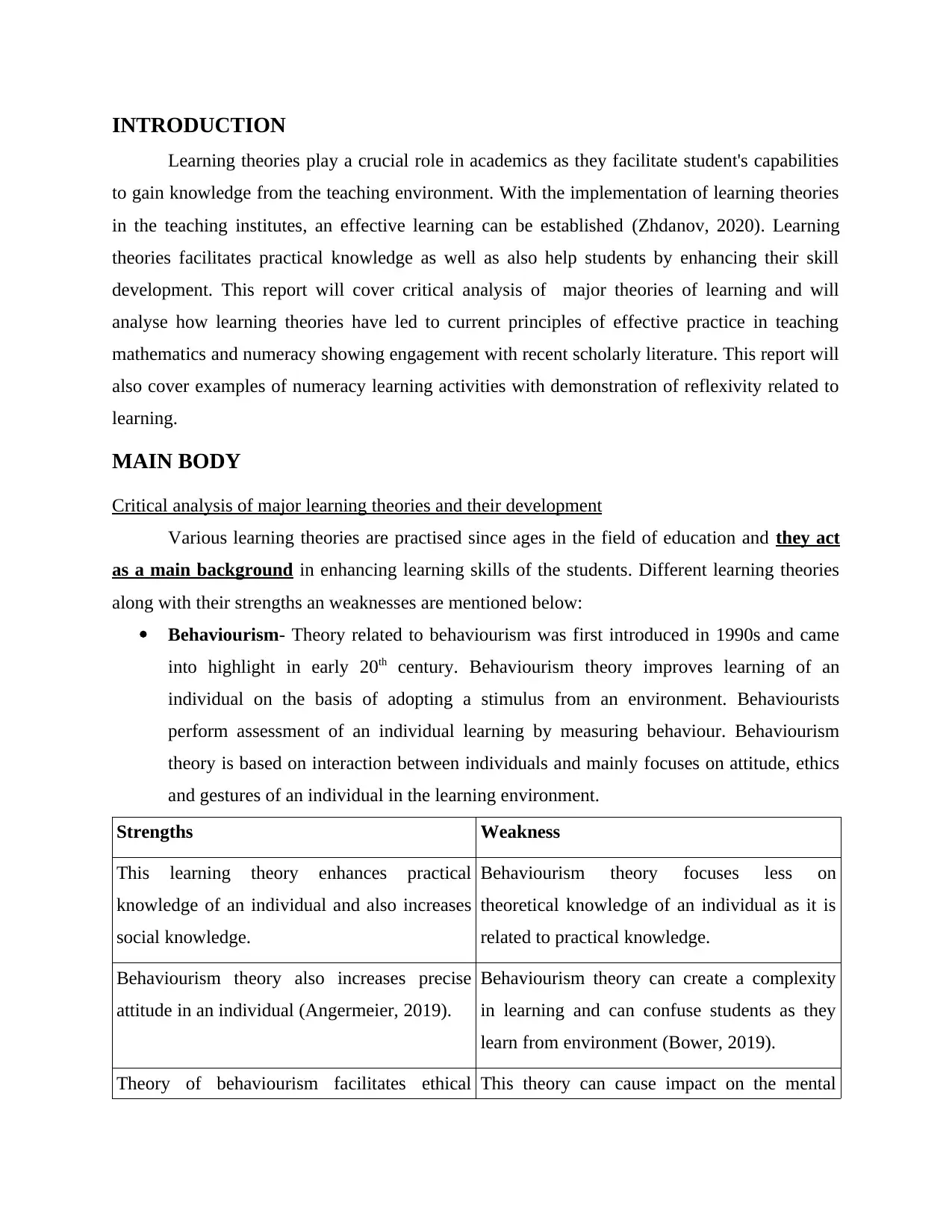
INTRODUCTION
Learning theories play a crucial role in academics as they facilitate student's capabilities
to gain knowledge from the teaching environment. With the implementation of learning theories
in the teaching institutes, an effective learning can be established (Zhdanov, 2020). Learning
theories facilitates practical knowledge as well as also help students by enhancing their skill
development. This report will cover critical analysis of major theories of learning and will
analyse how learning theories have led to current principles of effective practice in teaching
mathematics and numeracy showing engagement with recent scholarly literature. This report will
also cover examples of numeracy learning activities with demonstration of reflexivity related to
learning.
MAIN BODY
Critical analysis of major learning theories and their development
Various learning theories are practised since ages in the field of education and they act
as a main background in enhancing learning skills of the students. Different learning theories
along with their strengths an weaknesses are mentioned below:
Behaviourism- Theory related to behaviourism was first introduced in 1990s and came
into highlight in early 20th century. Behaviourism theory improves learning of an
individual on the basis of adopting a stimulus from an environment. Behaviourists
perform assessment of an individual learning by measuring behaviour. Behaviourism
theory is based on interaction between individuals and mainly focuses on attitude, ethics
and gestures of an individual in the learning environment.
Strengths Weakness
This learning theory enhances practical
knowledge of an individual and also increases
social knowledge.
Behaviourism theory focuses less on
theoretical knowledge of an individual as it is
related to practical knowledge.
Behaviourism theory also increases precise
attitude in an individual (Angermeier, 2019).
Behaviourism theory can create a complexity
in learning and can confuse students as they
learn from environment (Bower, 2019).
Theory of behaviourism facilitates ethical This theory can cause impact on the mental
Learning theories play a crucial role in academics as they facilitate student's capabilities
to gain knowledge from the teaching environment. With the implementation of learning theories
in the teaching institutes, an effective learning can be established (Zhdanov, 2020). Learning
theories facilitates practical knowledge as well as also help students by enhancing their skill
development. This report will cover critical analysis of major theories of learning and will
analyse how learning theories have led to current principles of effective practice in teaching
mathematics and numeracy showing engagement with recent scholarly literature. This report will
also cover examples of numeracy learning activities with demonstration of reflexivity related to
learning.
MAIN BODY
Critical analysis of major learning theories and their development
Various learning theories are practised since ages in the field of education and they act
as a main background in enhancing learning skills of the students. Different learning theories
along with their strengths an weaknesses are mentioned below:
Behaviourism- Theory related to behaviourism was first introduced in 1990s and came
into highlight in early 20th century. Behaviourism theory improves learning of an
individual on the basis of adopting a stimulus from an environment. Behaviourists
perform assessment of an individual learning by measuring behaviour. Behaviourism
theory is based on interaction between individuals and mainly focuses on attitude, ethics
and gestures of an individual in the learning environment.
Strengths Weakness
This learning theory enhances practical
knowledge of an individual and also increases
social knowledge.
Behaviourism theory focuses less on
theoretical knowledge of an individual as it is
related to practical knowledge.
Behaviourism theory also increases precise
attitude in an individual (Angermeier, 2019).
Behaviourism theory can create a complexity
in learning and can confuse students as they
learn from environment (Bower, 2019).
Theory of behaviourism facilitates ethical This theory can cause impact on the mental
⊘ This is a preview!⊘
Do you want full access?
Subscribe today to unlock all pages.

Trusted by 1+ million students worldwide
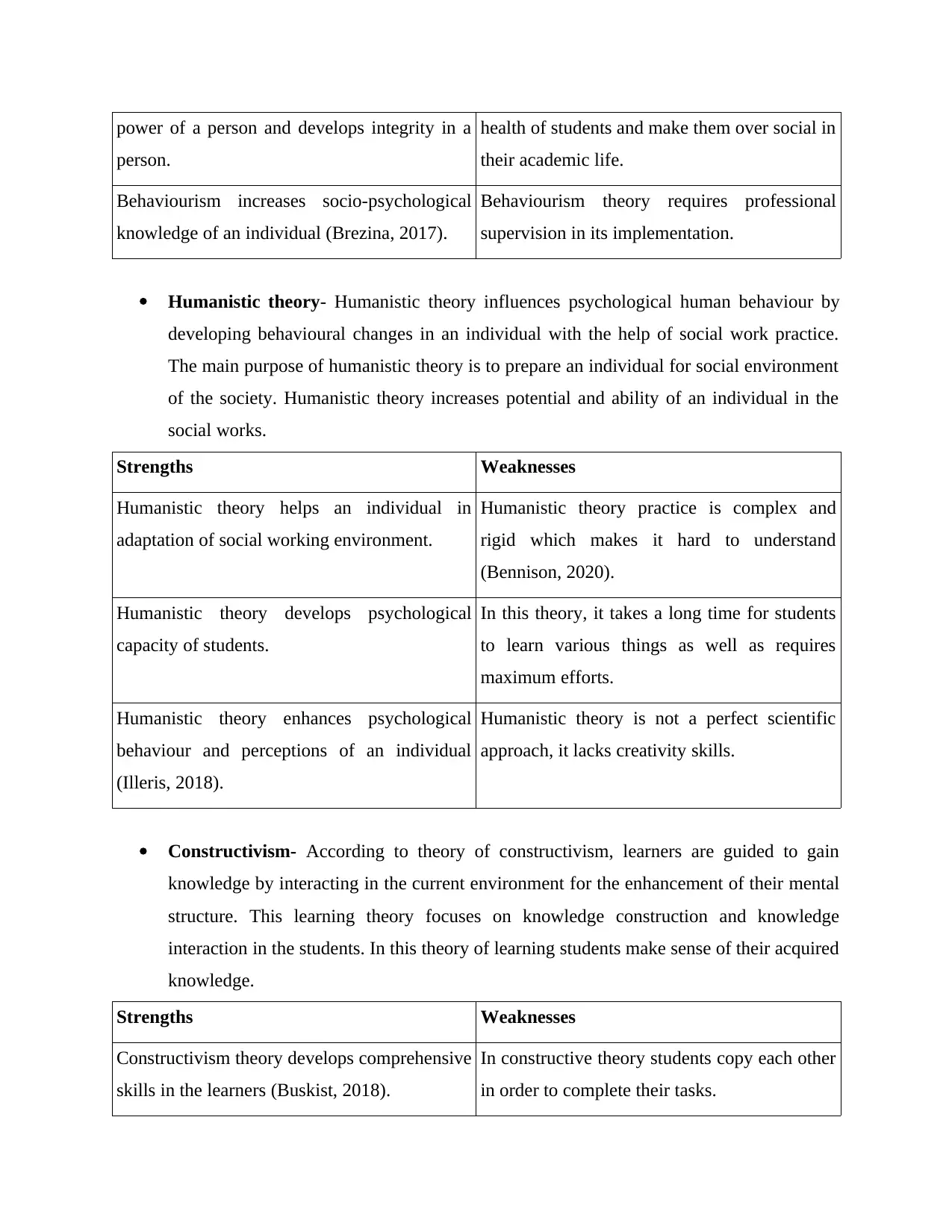
power of a person and develops integrity in a
person.
health of students and make them over social in
their academic life.
Behaviourism increases socio-psychological
knowledge of an individual (Brezina, 2017).
Behaviourism theory requires professional
supervision in its implementation.
Humanistic theory- Humanistic theory influences psychological human behaviour by
developing behavioural changes in an individual with the help of social work practice.
The main purpose of humanistic theory is to prepare an individual for social environment
of the society. Humanistic theory increases potential and ability of an individual in the
social works.
Strengths Weaknesses
Humanistic theory helps an individual in
adaptation of social working environment.
Humanistic theory practice is complex and
rigid which makes it hard to understand
(Bennison, 2020).
Humanistic theory develops psychological
capacity of students.
In this theory, it takes a long time for students
to learn various things as well as requires
maximum efforts.
Humanistic theory enhances psychological
behaviour and perceptions of an individual
(Illeris, 2018).
Humanistic theory is not a perfect scientific
approach, it lacks creativity skills.
Constructivism- According to theory of constructivism, learners are guided to gain
knowledge by interacting in the current environment for the enhancement of their mental
structure. This learning theory focuses on knowledge construction and knowledge
interaction in the students. In this theory of learning students make sense of their acquired
knowledge.
Strengths Weaknesses
Constructivism theory develops comprehensive
skills in the learners (Buskist, 2018).
In constructive theory students copy each other
in order to complete their tasks.
person.
health of students and make them over social in
their academic life.
Behaviourism increases socio-psychological
knowledge of an individual (Brezina, 2017).
Behaviourism theory requires professional
supervision in its implementation.
Humanistic theory- Humanistic theory influences psychological human behaviour by
developing behavioural changes in an individual with the help of social work practice.
The main purpose of humanistic theory is to prepare an individual for social environment
of the society. Humanistic theory increases potential and ability of an individual in the
social works.
Strengths Weaknesses
Humanistic theory helps an individual in
adaptation of social working environment.
Humanistic theory practice is complex and
rigid which makes it hard to understand
(Bennison, 2020).
Humanistic theory develops psychological
capacity of students.
In this theory, it takes a long time for students
to learn various things as well as requires
maximum efforts.
Humanistic theory enhances psychological
behaviour and perceptions of an individual
(Illeris, 2018).
Humanistic theory is not a perfect scientific
approach, it lacks creativity skills.
Constructivism- According to theory of constructivism, learners are guided to gain
knowledge by interacting in the current environment for the enhancement of their mental
structure. This learning theory focuses on knowledge construction and knowledge
interaction in the students. In this theory of learning students make sense of their acquired
knowledge.
Strengths Weaknesses
Constructivism theory develops comprehensive
skills in the learners (Buskist, 2018).
In constructive theory students copy each other
in order to complete their tasks.
Paraphrase This Document
Need a fresh take? Get an instant paraphrase of this document with our AI Paraphraser
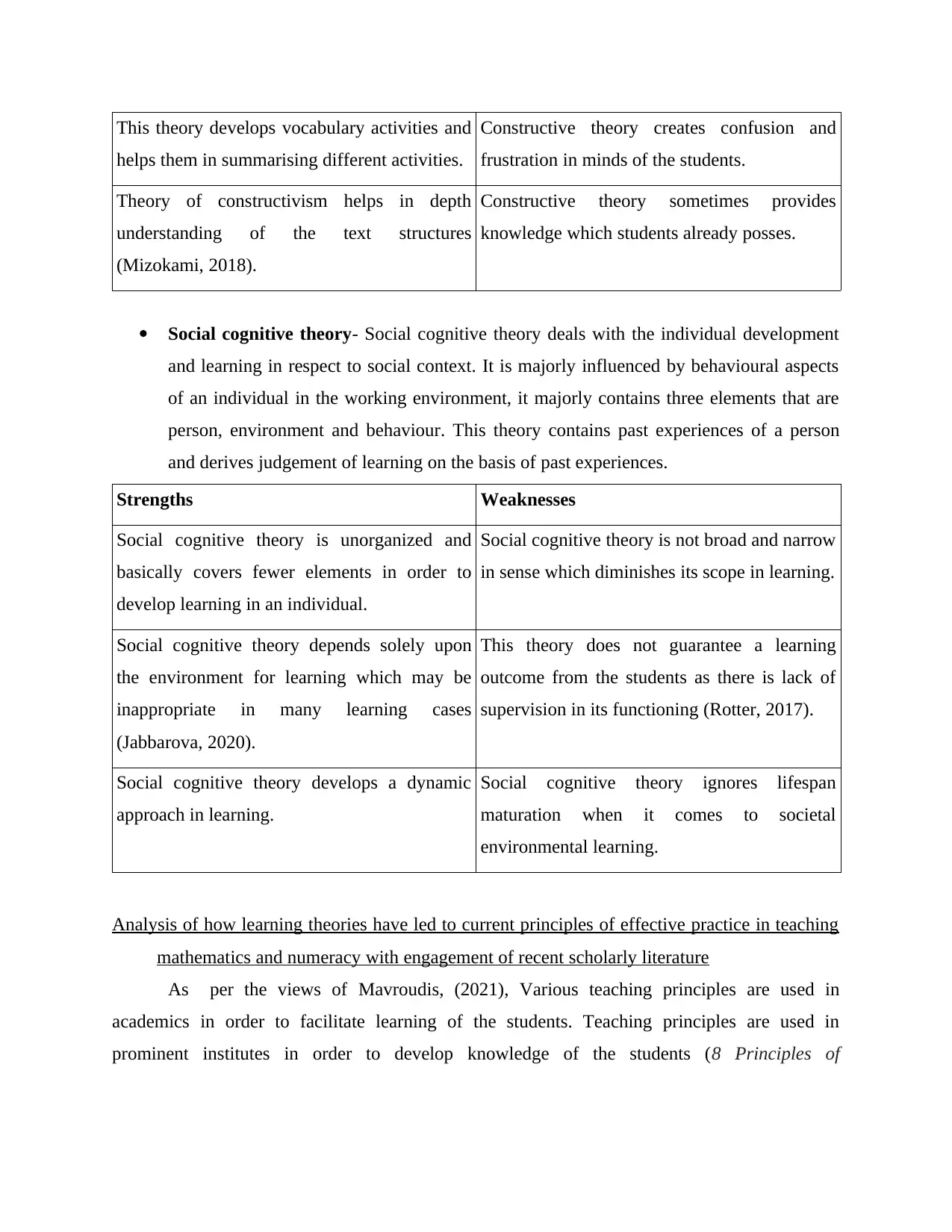
This theory develops vocabulary activities and
helps them in summarising different activities.
Constructive theory creates confusion and
frustration in minds of the students.
Theory of constructivism helps in depth
understanding of the text structures
(Mizokami, 2018).
Constructive theory sometimes provides
knowledge which students already posses.
Social cognitive theory- Social cognitive theory deals with the individual development
and learning in respect to social context. It is majorly influenced by behavioural aspects
of an individual in the working environment, it majorly contains three elements that are
person, environment and behaviour. This theory contains past experiences of a person
and derives judgement of learning on the basis of past experiences.
Strengths Weaknesses
Social cognitive theory is unorganized and
basically covers fewer elements in order to
develop learning in an individual.
Social cognitive theory is not broad and narrow
in sense which diminishes its scope in learning.
Social cognitive theory depends solely upon
the environment for learning which may be
inappropriate in many learning cases
(Jabbarova, 2020).
This theory does not guarantee a learning
outcome from the students as there is lack of
supervision in its functioning (Rotter, 2017).
Social cognitive theory develops a dynamic
approach in learning.
Social cognitive theory ignores lifespan
maturation when it comes to societal
environmental learning.
Analysis of how learning theories have led to current principles of effective practice in teaching
mathematics and numeracy with engagement of recent scholarly literature
As per the views of Mavroudis, (2021), Various teaching principles are used in
academics in order to facilitate learning of the students. Teaching principles are used in
prominent institutes in order to develop knowledge of the students (8 Principles of
helps them in summarising different activities.
Constructive theory creates confusion and
frustration in minds of the students.
Theory of constructivism helps in depth
understanding of the text structures
(Mizokami, 2018).
Constructive theory sometimes provides
knowledge which students already posses.
Social cognitive theory- Social cognitive theory deals with the individual development
and learning in respect to social context. It is majorly influenced by behavioural aspects
of an individual in the working environment, it majorly contains three elements that are
person, environment and behaviour. This theory contains past experiences of a person
and derives judgement of learning on the basis of past experiences.
Strengths Weaknesses
Social cognitive theory is unorganized and
basically covers fewer elements in order to
develop learning in an individual.
Social cognitive theory is not broad and narrow
in sense which diminishes its scope in learning.
Social cognitive theory depends solely upon
the environment for learning which may be
inappropriate in many learning cases
(Jabbarova, 2020).
This theory does not guarantee a learning
outcome from the students as there is lack of
supervision in its functioning (Rotter, 2017).
Social cognitive theory develops a dynamic
approach in learning.
Social cognitive theory ignores lifespan
maturation when it comes to societal
environmental learning.
Analysis of how learning theories have led to current principles of effective practice in teaching
mathematics and numeracy with engagement of recent scholarly literature
As per the views of Mavroudis, (2021), Various teaching principles are used in
academics in order to facilitate learning of the students. Teaching principles are used in
prominent institutes in order to develop knowledge of the students (8 Principles of
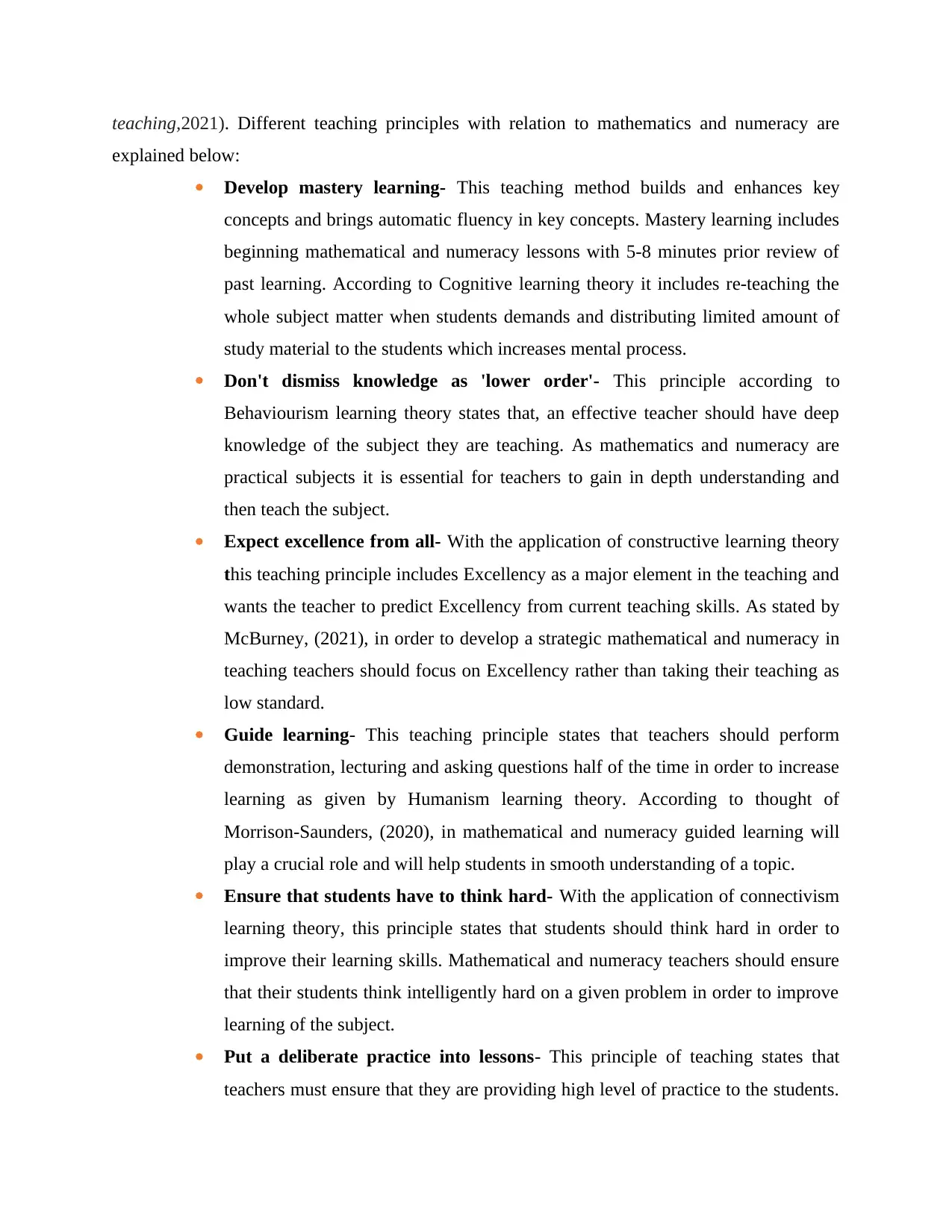
teaching,2021). Different teaching principles with relation to mathematics and numeracy are
explained below:
Develop mastery learning- This teaching method builds and enhances key
concepts and brings automatic fluency in key concepts. Mastery learning includes
beginning mathematical and numeracy lessons with 5-8 minutes prior review of
past learning. According to Cognitive learning theory it includes re-teaching the
whole subject matter when students demands and distributing limited amount of
study material to the students which increases mental process.
Don't dismiss knowledge as 'lower order'- This principle according to
Behaviourism learning theory states that, an effective teacher should have deep
knowledge of the subject they are teaching. As mathematics and numeracy are
practical subjects it is essential for teachers to gain in depth understanding and
then teach the subject.
Expect excellence from all- With the application of constructive learning theory
this teaching principle includes Excellency as a major element in the teaching and
wants the teacher to predict Excellency from current teaching skills. As stated by
McBurney, (2021), in order to develop a strategic mathematical and numeracy in
teaching teachers should focus on Excellency rather than taking their teaching as
low standard.
Guide learning- This teaching principle states that teachers should perform
demonstration, lecturing and asking questions half of the time in order to increase
learning as given by Humanism learning theory. According to thought of
Morrison-Saunders, (2020), in mathematical and numeracy guided learning will
play a crucial role and will help students in smooth understanding of a topic.
Ensure that students have to think hard- With the application of connectivism
learning theory, this principle states that students should think hard in order to
improve their learning skills. Mathematical and numeracy teachers should ensure
that their students think intelligently hard on a given problem in order to improve
learning of the subject.
Put a deliberate practice into lessons- This principle of teaching states that
teachers must ensure that they are providing high level of practice to the students.
explained below:
Develop mastery learning- This teaching method builds and enhances key
concepts and brings automatic fluency in key concepts. Mastery learning includes
beginning mathematical and numeracy lessons with 5-8 minutes prior review of
past learning. According to Cognitive learning theory it includes re-teaching the
whole subject matter when students demands and distributing limited amount of
study material to the students which increases mental process.
Don't dismiss knowledge as 'lower order'- This principle according to
Behaviourism learning theory states that, an effective teacher should have deep
knowledge of the subject they are teaching. As mathematics and numeracy are
practical subjects it is essential for teachers to gain in depth understanding and
then teach the subject.
Expect excellence from all- With the application of constructive learning theory
this teaching principle includes Excellency as a major element in the teaching and
wants the teacher to predict Excellency from current teaching skills. As stated by
McBurney, (2021), in order to develop a strategic mathematical and numeracy in
teaching teachers should focus on Excellency rather than taking their teaching as
low standard.
Guide learning- This teaching principle states that teachers should perform
demonstration, lecturing and asking questions half of the time in order to increase
learning as given by Humanism learning theory. According to thought of
Morrison-Saunders, (2020), in mathematical and numeracy guided learning will
play a crucial role and will help students in smooth understanding of a topic.
Ensure that students have to think hard- With the application of connectivism
learning theory, this principle states that students should think hard in order to
improve their learning skills. Mathematical and numeracy teachers should ensure
that their students think intelligently hard on a given problem in order to improve
learning of the subject.
Put a deliberate practice into lessons- This principle of teaching states that
teachers must ensure that they are providing high level of practice to the students.
⊘ This is a preview!⊘
Do you want full access?
Subscribe today to unlock all pages.

Trusted by 1+ million students worldwide
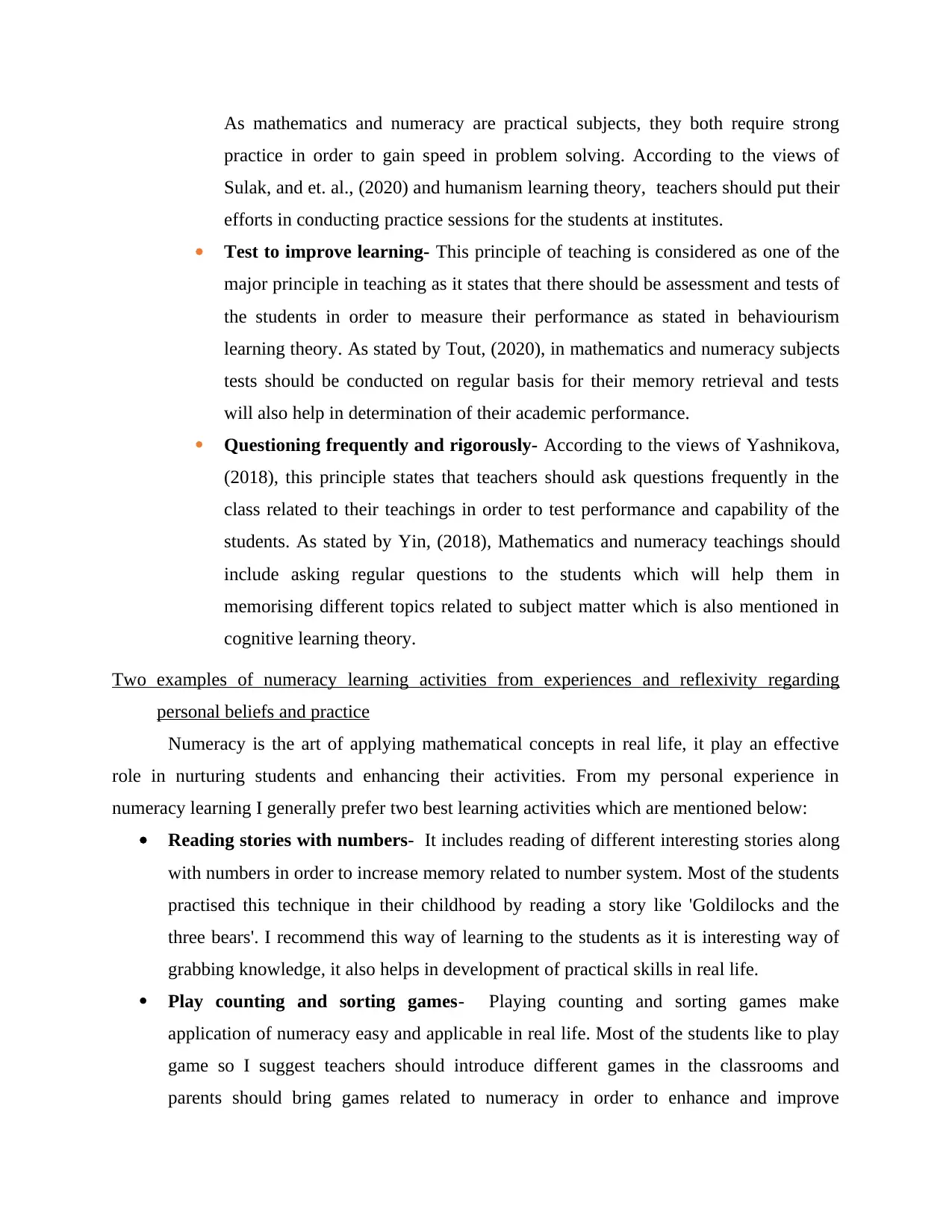
As mathematics and numeracy are practical subjects, they both require strong
practice in order to gain speed in problem solving. According to the views of
Sulak, and et. al., (2020) and humanism learning theory, teachers should put their
efforts in conducting practice sessions for the students at institutes.
Test to improve learning- This principle of teaching is considered as one of the
major principle in teaching as it states that there should be assessment and tests of
the students in order to measure their performance as stated in behaviourism
learning theory. As stated by Tout, (2020), in mathematics and numeracy subjects
tests should be conducted on regular basis for their memory retrieval and tests
will also help in determination of their academic performance.
Questioning frequently and rigorously- According to the views of Yashnikova,
(2018), this principle states that teachers should ask questions frequently in the
class related to their teachings in order to test performance and capability of the
students. As stated by Yin, (2018), Mathematics and numeracy teachings should
include asking regular questions to the students which will help them in
memorising different topics related to subject matter which is also mentioned in
cognitive learning theory.
Two examples of numeracy learning activities from experiences and reflexivity regarding
personal beliefs and practice
Numeracy is the art of applying mathematical concepts in real life, it play an effective
role in nurturing students and enhancing their activities. From my personal experience in
numeracy learning I generally prefer two best learning activities which are mentioned below:
Reading stories with numbers- It includes reading of different interesting stories along
with numbers in order to increase memory related to number system. Most of the students
practised this technique in their childhood by reading a story like 'Goldilocks and the
three bears'. I recommend this way of learning to the students as it is interesting way of
grabbing knowledge, it also helps in development of practical skills in real life.
Play counting and sorting games- Playing counting and sorting games make
application of numeracy easy and applicable in real life. Most of the students like to play
game so I suggest teachers should introduce different games in the classrooms and
parents should bring games related to numeracy in order to enhance and improve
practice in order to gain speed in problem solving. According to the views of
Sulak, and et. al., (2020) and humanism learning theory, teachers should put their
efforts in conducting practice sessions for the students at institutes.
Test to improve learning- This principle of teaching is considered as one of the
major principle in teaching as it states that there should be assessment and tests of
the students in order to measure their performance as stated in behaviourism
learning theory. As stated by Tout, (2020), in mathematics and numeracy subjects
tests should be conducted on regular basis for their memory retrieval and tests
will also help in determination of their academic performance.
Questioning frequently and rigorously- According to the views of Yashnikova,
(2018), this principle states that teachers should ask questions frequently in the
class related to their teachings in order to test performance and capability of the
students. As stated by Yin, (2018), Mathematics and numeracy teachings should
include asking regular questions to the students which will help them in
memorising different topics related to subject matter which is also mentioned in
cognitive learning theory.
Two examples of numeracy learning activities from experiences and reflexivity regarding
personal beliefs and practice
Numeracy is the art of applying mathematical concepts in real life, it play an effective
role in nurturing students and enhancing their activities. From my personal experience in
numeracy learning I generally prefer two best learning activities which are mentioned below:
Reading stories with numbers- It includes reading of different interesting stories along
with numbers in order to increase memory related to number system. Most of the students
practised this technique in their childhood by reading a story like 'Goldilocks and the
three bears'. I recommend this way of learning to the students as it is interesting way of
grabbing knowledge, it also helps in development of practical skills in real life.
Play counting and sorting games- Playing counting and sorting games make
application of numeracy easy and applicable in real life. Most of the students like to play
game so I suggest teachers should introduce different games in the classrooms and
parents should bring games related to numeracy in order to enhance and improve
Paraphrase This Document
Need a fresh take? Get an instant paraphrase of this document with our AI Paraphraser
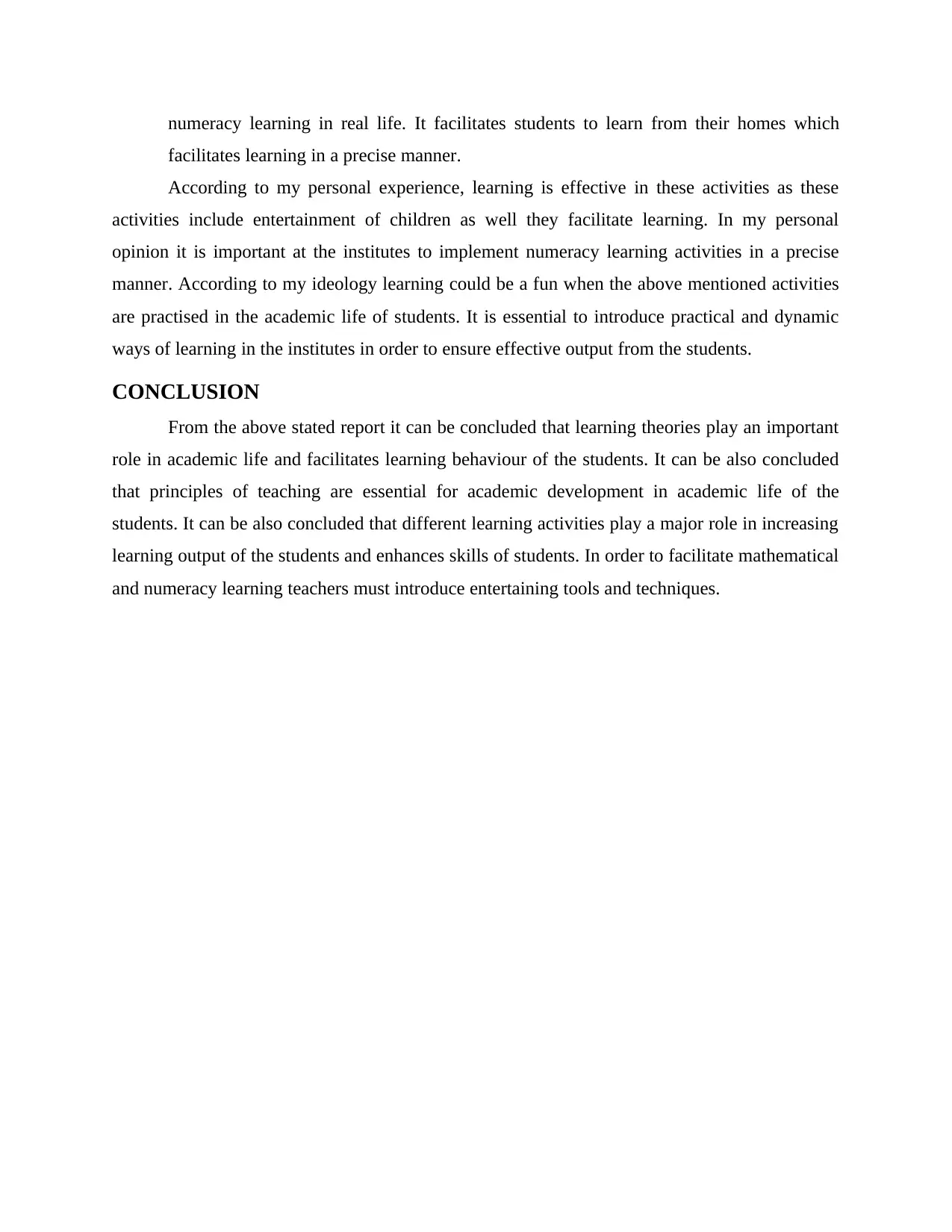
numeracy learning in real life. It facilitates students to learn from their homes which
facilitates learning in a precise manner.
According to my personal experience, learning is effective in these activities as these
activities include entertainment of children as well they facilitate learning. In my personal
opinion it is important at the institutes to implement numeracy learning activities in a precise
manner. According to my ideology learning could be a fun when the above mentioned activities
are practised in the academic life of students. It is essential to introduce practical and dynamic
ways of learning in the institutes in order to ensure effective output from the students.
CONCLUSION
From the above stated report it can be concluded that learning theories play an important
role in academic life and facilitates learning behaviour of the students. It can be also concluded
that principles of teaching are essential for academic development in academic life of the
students. It can be also concluded that different learning activities play a major role in increasing
learning output of the students and enhances skills of students. In order to facilitate mathematical
and numeracy learning teachers must introduce entertaining tools and techniques.
facilitates learning in a precise manner.
According to my personal experience, learning is effective in these activities as these
activities include entertainment of children as well they facilitate learning. In my personal
opinion it is important at the institutes to implement numeracy learning activities in a precise
manner. According to my ideology learning could be a fun when the above mentioned activities
are practised in the academic life of students. It is essential to introduce practical and dynamic
ways of learning in the institutes in order to ensure effective output from the students.
CONCLUSION
From the above stated report it can be concluded that learning theories play an important
role in academic life and facilitates learning behaviour of the students. It can be also concluded
that principles of teaching are essential for academic development in academic life of the
students. It can be also concluded that different learning activities play a major role in increasing
learning output of the students and enhances skills of students. In order to facilitate mathematical
and numeracy learning teachers must introduce entertaining tools and techniques.
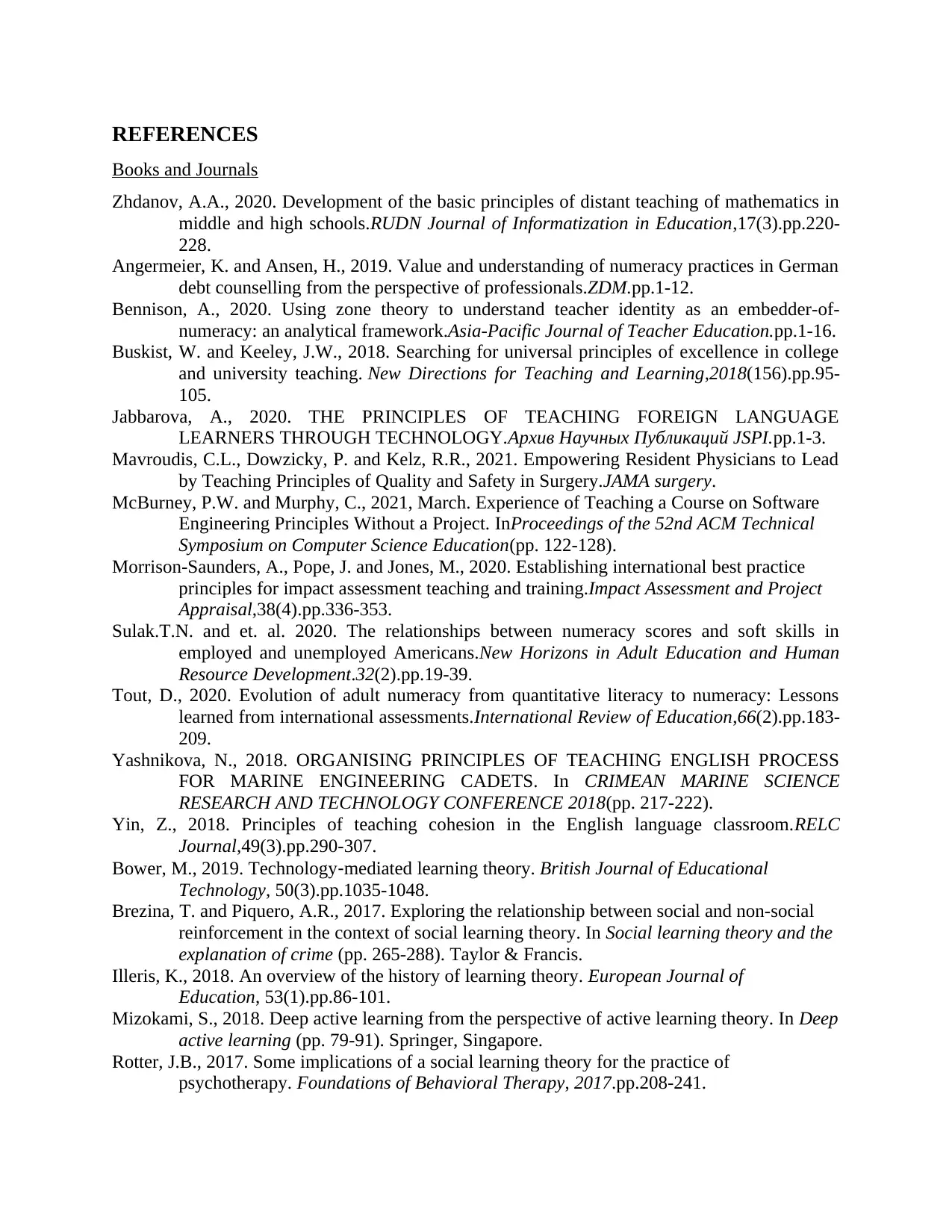
REFERENCES
Books and Journals
Zhdanov, A.A., 2020. Development of the basic principles of distant teaching of mathematics in
middle and high schools.RUDN Journal of Informatization in Education,17(3).pp.220-
228.
Angermeier, K. and Ansen, H., 2019. Value and understanding of numeracy practices in German
debt counselling from the perspective of professionals.ZDM.pp.1-12.
Bennison, A., 2020. Using zone theory to understand teacher identity as an embedder-of-
numeracy: an analytical framework.Asia-Pacific Journal of Teacher Education.pp.1-16.
Buskist, W. and Keeley, J.W., 2018. Searching for universal principles of excellence in college
and university teaching. New Directions for Teaching and Learning,2018(156).pp.95-
105.
Jabbarova, A., 2020. THE PRINCIPLES OF TEACHING FOREIGN LANGUAGE
LEARNERS THROUGH TECHNOLOGY.Архив Научных Публикаций JSPI.pp.1-3.
Mavroudis, C.L., Dowzicky, P. and Kelz, R.R., 2021. Empowering Resident Physicians to Lead
by Teaching Principles of Quality and Safety in Surgery.JAMA surgery.
McBurney, P.W. and Murphy, C., 2021, March. Experience of Teaching a Course on Software
Engineering Principles Without a Project. InProceedings of the 52nd ACM Technical
Symposium on Computer Science Education(pp. 122-128).
Morrison-Saunders, A., Pope, J. and Jones, M., 2020. Establishing international best practice
principles for impact assessment teaching and training.Impact Assessment and Project
Appraisal,38(4).pp.336-353.
Sulak.T.N. and et. al. 2020. The relationships between numeracy scores and soft skills in
employed and unemployed Americans.New Horizons in Adult Education and Human
Resource Development.32(2).pp.19-39.
Tout, D., 2020. Evolution of adult numeracy from quantitative literacy to numeracy: Lessons
learned from international assessments.International Review of Education,66(2).pp.183-
209.
Yashnikova, N., 2018. ORGANISING PRINCIPLES OF TEACHING ENGLISH PROCESS
FOR MARINE ENGINEERING CADETS. In CRIMEAN MARINE SCIENCE
RESEARCH AND TECHNOLOGY CONFERENCE 2018(pp. 217-222).
Yin, Z., 2018. Principles of teaching cohesion in the English language classroom.RELC
Journal,49(3).pp.290-307.
Bower, M., 2019. Technology‐mediated learning theory. British Journal of Educational
Technology, 50(3).pp.1035-1048.
Brezina, T. and Piquero, A.R., 2017. Exploring the relationship between social and non-social
reinforcement in the context of social learning theory. In Social learning theory and the
explanation of crime (pp. 265-288). Taylor & Francis.
Illeris, K., 2018. An overview of the history of learning theory. European Journal of
Education, 53(1).pp.86-101.
Mizokami, S., 2018. Deep active learning from the perspective of active learning theory. In Deep
active learning (pp. 79-91). Springer, Singapore.
Rotter, J.B., 2017. Some implications of a social learning theory for the practice of
psychotherapy. Foundations of Behavioral Therapy, 2017.pp.208-241.
Books and Journals
Zhdanov, A.A., 2020. Development of the basic principles of distant teaching of mathematics in
middle and high schools.RUDN Journal of Informatization in Education,17(3).pp.220-
228.
Angermeier, K. and Ansen, H., 2019. Value and understanding of numeracy practices in German
debt counselling from the perspective of professionals.ZDM.pp.1-12.
Bennison, A., 2020. Using zone theory to understand teacher identity as an embedder-of-
numeracy: an analytical framework.Asia-Pacific Journal of Teacher Education.pp.1-16.
Buskist, W. and Keeley, J.W., 2018. Searching for universal principles of excellence in college
and university teaching. New Directions for Teaching and Learning,2018(156).pp.95-
105.
Jabbarova, A., 2020. THE PRINCIPLES OF TEACHING FOREIGN LANGUAGE
LEARNERS THROUGH TECHNOLOGY.Архив Научных Публикаций JSPI.pp.1-3.
Mavroudis, C.L., Dowzicky, P. and Kelz, R.R., 2021. Empowering Resident Physicians to Lead
by Teaching Principles of Quality and Safety in Surgery.JAMA surgery.
McBurney, P.W. and Murphy, C., 2021, March. Experience of Teaching a Course on Software
Engineering Principles Without a Project. InProceedings of the 52nd ACM Technical
Symposium on Computer Science Education(pp. 122-128).
Morrison-Saunders, A., Pope, J. and Jones, M., 2020. Establishing international best practice
principles for impact assessment teaching and training.Impact Assessment and Project
Appraisal,38(4).pp.336-353.
Sulak.T.N. and et. al. 2020. The relationships between numeracy scores and soft skills in
employed and unemployed Americans.New Horizons in Adult Education and Human
Resource Development.32(2).pp.19-39.
Tout, D., 2020. Evolution of adult numeracy from quantitative literacy to numeracy: Lessons
learned from international assessments.International Review of Education,66(2).pp.183-
209.
Yashnikova, N., 2018. ORGANISING PRINCIPLES OF TEACHING ENGLISH PROCESS
FOR MARINE ENGINEERING CADETS. In CRIMEAN MARINE SCIENCE
RESEARCH AND TECHNOLOGY CONFERENCE 2018(pp. 217-222).
Yin, Z., 2018. Principles of teaching cohesion in the English language classroom.RELC
Journal,49(3).pp.290-307.
Bower, M., 2019. Technology‐mediated learning theory. British Journal of Educational
Technology, 50(3).pp.1035-1048.
Brezina, T. and Piquero, A.R., 2017. Exploring the relationship between social and non-social
reinforcement in the context of social learning theory. In Social learning theory and the
explanation of crime (pp. 265-288). Taylor & Francis.
Illeris, K., 2018. An overview of the history of learning theory. European Journal of
Education, 53(1).pp.86-101.
Mizokami, S., 2018. Deep active learning from the perspective of active learning theory. In Deep
active learning (pp. 79-91). Springer, Singapore.
Rotter, J.B., 2017. Some implications of a social learning theory for the practice of
psychotherapy. Foundations of Behavioral Therapy, 2017.pp.208-241.
⊘ This is a preview!⊘
Do you want full access?
Subscribe today to unlock all pages.

Trusted by 1+ million students worldwide

Online
8 Principles of teaching.2021.[Online]Available through:<https://www.edutopia.org/article/8-
principles-deeper-learning>
8 Principles of teaching.2021.[Online]Available through:<https://www.edutopia.org/article/8-
principles-deeper-learning>
1 out of 10
Related Documents
Your All-in-One AI-Powered Toolkit for Academic Success.
+13062052269
info@desklib.com
Available 24*7 on WhatsApp / Email
![[object Object]](/_next/static/media/star-bottom.7253800d.svg)
Unlock your academic potential
Copyright © 2020–2025 A2Z Services. All Rights Reserved. Developed and managed by ZUCOL.





